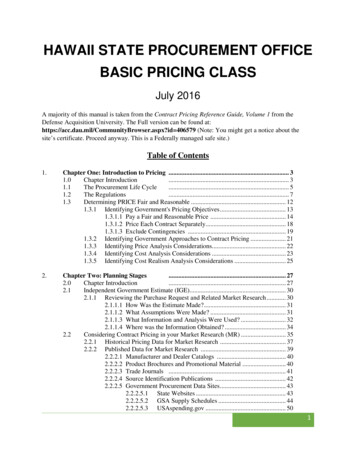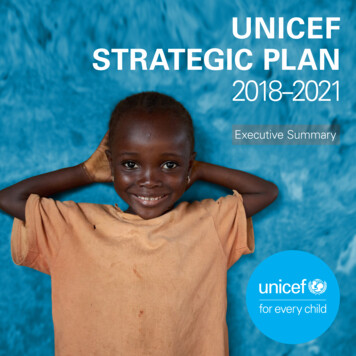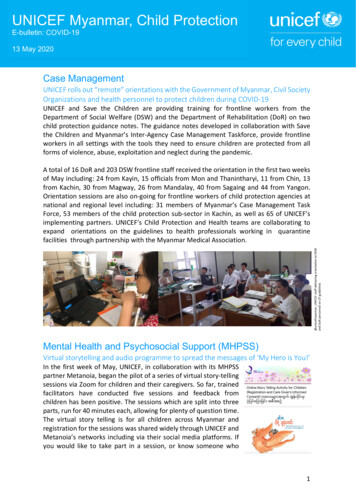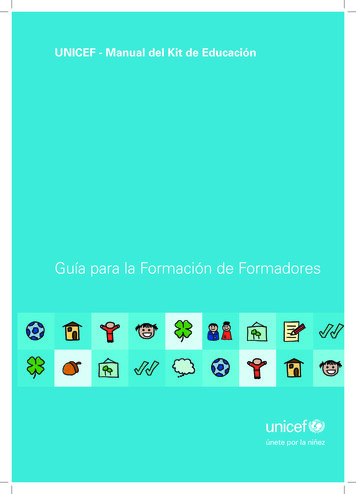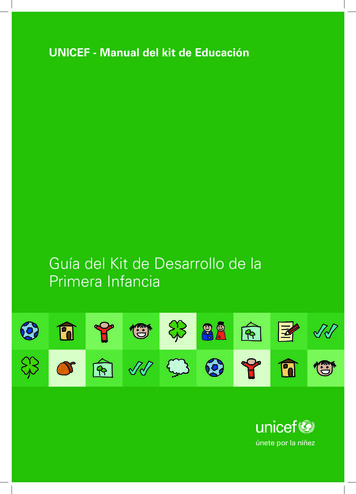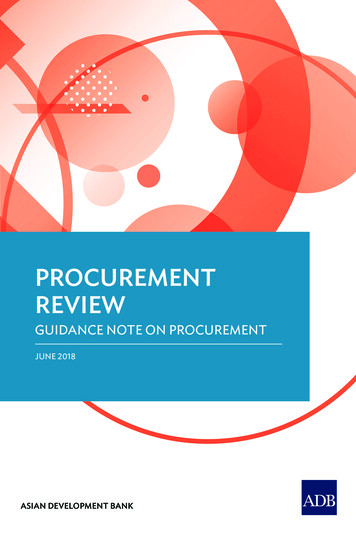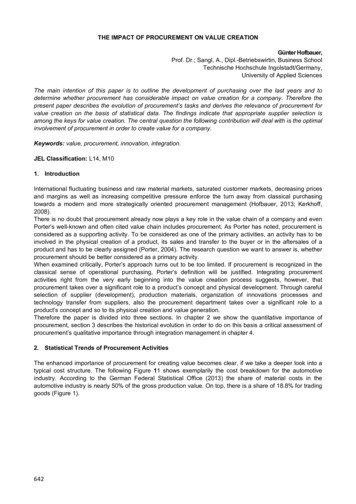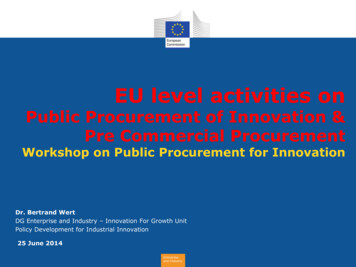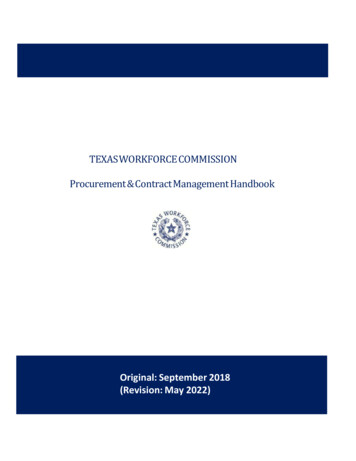
Transcription
UNICEF Procurement UpdateCynthia KamtengeniVerification system for health ProductsMax Kabalisa10th March 2022Joint UNICEF/UNFPA/WHO Health product supplier meetingVirtual Joint Meeting08 – 10 March 2022 UNICEF/Lister1
Our mission and visionA world where the rights of every child are realizedEvery childsurvives andthrivesEvery childlearns12Every child isprotected fromviolence andexploitationEvery childlives in a safeand cleanenvironmentEvery childhas anequitablechance in life345The UNICEF Supply Function helps realize child rights through ensuring access, availability and affordability of supplies andservicesVirtual Joint Meeting08 – 10 March 20222
UNICEF – how we work Works across 190 countries and territories Works with governments based on country specific agreements to address countryspecific needs and contexts Supports global efforts and works in partnerships with governments, other UNorganizations Is entirely funded by voluntary contributions from the public and the private sector;it does not receive funding from the UN Has an annual budget of approximately USD 5 billion to achieve results for children Works in Programmes, Advocacy, Innovation, Technical Assistance Supplies are an important component of this budget and are a direct expression ofchildren’s rightsVirtual Joint Meeting08 – 10 March 20223
2021 ProcurementOverviewCheck out our Annual es/annual-reportsVirtual Joint Meeting08 – 10 March 20224
UNICEF Procurement Value 2021NB.: All procurement figures are interim In 2021 UNICEF procurement rose to a record 6.277 billion worth of supplies andservices – representing a 40% increase from 2020 levels. This figure is the highest in the history of UNICEF and reflects an increase inprocurement related to COVID-19 pandemic response.Virtual Joint Meeting08 – 10 March 20225
UNICEF Procurement Value by major commoditygroups (2020)UNICEF procured 3.23 billion worth of goods in 2020. The eight highestvalue commodity groups and most common items procured within each arelisted.Emergency supply 682.5 millionprocured in 143 countries andareasProcurement services 1.808 billionon behalf of governments andpartnersVirtual Joint Meeting08 – 10 March 20226
UNICEF/UN0144182/RichProcurement Update onMedicinesVirtual Joint Meeting08 – 10 March 20227
BetaLactamsUNICEF Medicines & Nutrition neoplasticAntiprotozoalsMedicines fordiseases ofJointsRespiratoryWater drugsAntidotesEMLGastrointestinalNon dicinesInsulins hthalmologicalTherapeuticfoodsAntituberculosis
Medicines Procurement139 Suppliers in 36 countries, have been used to procure 377 standard UNICEF medicines presentations, which represent 95% of theprocurement. The medicines delivered to 90 countriesVirtual Joint Meeting08 – 10 March 20229
Tender Outcomes (current LTAs)Medicines Tender ConsiderationsGeneric names, or INN Dosage form, strength,Route of administration Validated analytical methods Stability (Accelerated andlong term)- Zone IVb Shelf life; 36 months totalshelf life preferred Bioequivalence/Comparative Packaging, labelling andpatient information leaflets Both manufacture and expirydate Usability (Scoring of tablets,dispersible tablets, dosemeasurement devices)ARVs – 77 products with 18 LTAs TechnicalCommercialVirtual Joint Meeting Quality Price Landed Cost Delivery Time/Speed MoQ Geographical location08 – 10 March 2022Antimalarials – 57 products with 17LTAsAntibiotics- 62 products with 48LTAsValueforMoneyAnthelminthics 7 products with 6LTAsORS&/Zinc (antidiarrhoeas) 10products with 8 LTAsNCD 29 products with 27 LTAsOther Essential medicines 212products with 84 LTAs10
UNICEF Supplier SharePoint Dossier Library In 2020 Medicine &Nutrition Center launched the Supplier DossierLibrary where suppliers can upload and update both product andmanufacturing site Technical documents. To request for the link, suppliers provide a list of products to offered. Each supplier folder contains: Site & Product documents folders. Instructions on how to upload and tag documents are provided alongwith the link to the specific Supplier folder on the SharePoint library. Reassessment for future tenders becomes easier as suppliers willonly be required to provide updates.Virtual Joint Meeting08 – 10 March 20221111
Supplier Library StructureVirtual Joint Meeting08 – 10 March 20221212
Interagency FinishedPharmaceutical ProductQuestionnaire (IFPPQ) –Automated template One form to be completed foreach FPP offered. Data on the IAPPQ is collated inexcel format via an aggregator.This saves time and avoidsmistakes that arise due tomanual transfer of information. The annexes to the IFPPQshould NOT be merged into asingle pdf document.13Virtual Joint Meeting08 – 10 March 202213
UNICEF extracts the PDF form data into Technical Evaluation Sheet14Virtual Joint Meeting08 – 10 March 202214
UNICEF GMP Inspections Due to Covid-19 travel restrictions UNICEF SD only performed a few on-siteGMP inspections in 2020 – 2021.UNICEF has in this period relayed heavily on current / past GMP inspectionscarried by our Partners in PIC/S and WHO PQ.If a full GMP inspection report is available to UNICEF, then an UNICEF GMPinspection can be waived.UNICEF SD will resume on-site GMP inspections as soon as the travelrestrictions are lifted.UNICEF SD has performed more than 20 remote GMP inspections in the period,but these have mainly been in the nutrition area.Virtual Joint Meeting08 – 10 March 202215
Upcoming Medicines Tenders in 2022Medicine CategoryTimelines COVID 19 Therapeutics Beta lactam (oral and injectables) ORS/zinc/resomal Antidiabetics Oncology Water and electrolytes AnthelminthicsTentative LaunchOngoingMarchMarchAprilMayJuneAugustCheck out the medicines tender dicines-tender-calendarVirtual Joint Meeting08 – 10 March 202216
Procurement Update on UNICEF/UN0144182/RichDiagnosticsVirtual Joint Meeting08 – 10 March 202217
UNICEF In Vitro Diagnostic Products Portfolio and Supply OperationsDiagnostic test kits 400 30Clinical Laboratory General lab equipment Analytical lab equipment, includinginnovative POC technologies for HIV earlyinfant diagnosis and viral load test Reagents and chemicals Plastic & glass ware Blood bank supplies Lab safety supplies 18,000,000QUALITY ASSUREDSTANDARDPRODUCTS 60 16MGLOBAL LONGTERMARRANGEMENTSRECEIVINGCOUNTRIESDIAGNOSTIC TESTSSUPPLIED ,000,000Procured quantity, tests IVDs for serological and RT-PCR assays forHIV, malaria, HBV, HCV, syphilis, Ebola,Zika and other diseases (cholera, dengue,leaismaniasis) Rapid pregnancy tests Urine strips Haemoglobin color scalesPan only12,000,000P. f. only10,000,0008,000,000P. f. andPv/Pvom6,000,000P. f. andpan4,000,000Man Moltests2,000,0000Lab basedplatforms201920202021UNICEF is a global player in public procurement of In Vitro diagnostics (IVDs) for high burden, high risk disease areas. In the past 3years UNICEF procured and delivered over 40 million quality assured diagnostic tests. UNICEF is one of the world largest publicprocurers of HIV RDTs, malaria RDTs.UNICEF collaboratively leverages its buying power; technical, contracting, financing and programmatic expertise to shape healthymarkets; to drive and accelerate development and scale-up of innovative diagnostics for better access, affordability and sustainableservice delivery – to improve the lives of all children.Virtual Joint Meeting08 – 10 March 202218
UNICEF COVID-19 Diagnostics Supply Operations18.0 millionUNICEF procured* over18.0 million Covid-19diagnostic tests15.0 millionUNICEF delivered* over15.5 million Covid-19diagnostic tests to 89countries19 manufacturersLTAs with 19 diagnosticsmanufacturers for acomprehensive range ofmolecular and rapidCovid-19 diagnostic tests* from the onset of the pandemicto dateVirtual Joint Meeting08 – 10 March 202219
UNICEF COVID-19 Diagnostics Supply PortfolioVirtual Joint Meeting08 – 10 March 202220
Procurement Update on UNICEF/UN0144182/RichVaccinesVirtual Joint Meeting08 – 10 March 202221
2021 UNICEF Vaccine Procurement Overview45%of children under fivereached, in over 100countries (throughonly 5% of the globalmarket share) in20204.1 billionUSDVolume of vaccinesprocured throughUNICEFbillion of doses26vaccine procurementthroughput*in 2021vaccines withdifferent productpresentations* Throughput valueexcludes valuation ofCOVID-19 vaccinedonations managed byUNICEF SDVirtual Joint Meeting08 – 10 March 202222
Tentative Vaccine Tender Calendar for the Upcoming PeriodVirtual Joint Meeting08 – 10 March 202223
Barcoding: towards full traceability of vaccines to improve efficiency of supply chain andprotect against falsification and diversionVendor to establish verification system2022UNICEF and partners to establish a Global Trust Repositorywith a vendor to support track and trace of COVID-19 vaccines2021On traceability of health products - linkWHO Policy2020UNICEF to indicate bar codes includingserialization as a preferred characteristicCOVID-19 Tender2020Consultation concluded September2019On status of GS1 barcoding/standards adoption2019Bar codes to be required on secondary packaging for tendersissued after October 2019 for supply starting 2022 - linkUNICEF & Gavi announcement2015Including language of bar codes as a preferred characteristicon packaging except primary.GTIN & Batch number & expiryUNICEF TENDERS2014Assessing the Programmatic Suitability of VaccineCandidates for WHO Prequalification - linkUNICEF Impact SurveySupply Base SurveyWHO GUIDELINEUNICEF Procurement activitiesNormative guidance
FINDINGS Multinational organisations supplying to many markets around the world; alreadyare subject to GS1 based serialisation legislation: U.S., Europe, India and China. 89% of UNICEF’s suppliers, which responded to our survey, already use GS1standards and 94% comply while supplying other customers. (ARVs, Anti-malarials,Beta-lactams & other products including anti- bacterial There is low market access risk for adopting GS1 serialisation for UNICEF’spharmaceutical suppliers. 89% of the suppliers are already using EPCIS messaging to exchange serialisationdata with supply chain partners. Serialisation is widely used by UNICEF’s pharmaceutical suppliers that respondedGS1 IMPACT EVALUATION STUDYAn evaluation of the price and market access risks toUNICEF pharmaceutical and healthcare productprocurement as a result of the mandatory adoption ofGS1 standards (2021).RECOMMENDATIONS LTAs for pharmaceuticals commencing after the 30th June 2022, should require thatpharmaceutical products carry GS1 bar-codes on the secondary packaging includingGTIN, batch/lot, expiry date and a serial number and that the tertiary packagingcarry GS1 bar codes including GTIN, batch/lot and expiry date. UNICEF will discuss with donors and partner organization on work with suppliers tosend serialisation data.Virtual Joint Meeting08 – 10 March 202225
Barcoding: a mandatory technical requirement in all vaccine tendersFor tenders issued after October 2019, thefollowing language is included in all vaccinetenders as part of mandatory technicalrequirements:“Bar CodesWith implementation latest 31st December 2021, barcodes are required on all packaging levels used bymanufacturers for supply to UNICEF, with the exception ofprimary packaging. Bar codes shall conform to GS1standards, allowing through a unique company prefix toidentify vaccines available in the global supply chain fromeach manufacturer. The bar codes shall include GlobalTrade Item Number (GTIN), lot number and expiry date.”Exceptionally for the Covid-19 tender, thefollowing is included as a preferred characteristic:In addition to the standard requirements,serialization is required.Virtual Joint Meeting08 – 10 March 202226
WHAT’S GTR? Global database hosting serialized number of health products,including COVID-19 Vaccines and routine immunization vaccinesbased on GS1. Product unique identifier. Interoperability capabilities with other SC systems to supporttraceability. Use compatible open standards for the capture and exchange ofverification/traceability data.WHY GTR? Minimizing patients’ exposure to risk associated with falsifiedhealth products. Support regulatory authorities taking fast actions in theirjurisdiction and concerted risk mitigation actions to prevent flowof falsified health product into the national supply chain. Foundation for a fully fledged traceability system to fight againstfalsified medicines, facilitate batch recalls, mitigate shortages ofmedicines and improve pharmacovigilance. Setting the stage to enable the use of widely acceptedinternational data sharing standards.Virtual Joint Meeting08 – 10 March 20221. WHAT & WHY GTR?GTR is not an innovation rather a database built on GS1that is simple to deploy and a foundation to a full trackand trace system like those deployed in high-incomecountries.27
2. GTR USE CASESUse case 1: Verification/batch recallCapability to verify product authenticityusing different tools such as system- to –system integration, Mobile applicationinterface, scanning equipment and system to -app integration. Global unique product identifier (e.g., GTIN Serial number) Standardized information included in thecarrier (e.g., Product Identifier, Batchnumber, Expiry Date, Serial Number)Use case 3: Product visibilityDashboard for verification events that supportsmanagement decisions. The user will haveaccess to the dashboard based on their roles.The system is capable to interface with existingtraceability & SC systems to enhance productvisibility within the supply chain to supportstock management. Capability to aggregate and analyze date basedon selected KPIs The analysis can help inform decision makingby relevant entities to improvepharmacovigilance systems, supply planningand stock status.Cross-system authentication standards andcapabilities.Manufacturer Data on distribution at patient level couldbe compared with reporting levels and helpto inform the development of efficientpharmacovigilance systemsVirtual Joint Meeting08 – 10 March 2022Standardinterface Use case 2: DashboardEnables SC partners to share informationabout the physical movement and status ofproducts as they travel throughout the supplychain. Improve stock management by providingscanned data which may be entered into anystock management platform, such as Thrive360, DHIS2 supply module, eLMIS etc. An optional product verification capability foruse where there is no national system in place. A reporting and dashboard capability whichsupports the monitoring of verification eventsand locationsGlobal TrustrepositoryStandard interfaceNationalSystemAuthorities ManufacturersDonorOrganisationsGovernmentOfficials
UNICEF is the United Nations International Children's Emergency Fund and is mandated by the United Nations General Assembly to\ഠadvocate for the protection of children's rights, to help meet their basic needs and to expand their opportunities to reach the對ir full potential.\爀屲Five goal areas, as presented in the slide, drive progress towards realizing the rights of every child, es .
